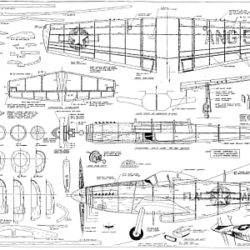North American P-51H Mustang historical facts
The first North American P-51H Mustang flew on February 3, 1945. The lightweight P-51H retained some of the weight-saving features of the experimental lightweight models, but included major compromises to make it into a viable combat aircraft. Contract No. AC-1752 of 26 April 1944 covered the manufacture of 2,400 P-51Hs (NA-126s). There was no prototype for the P-51H, as the development work carried out on the other lightweight Mustangs prepared the way for P-51H production to begin without the necessity for further prototypes.
The initial North American P-51H Mustang production aircraft were somewhat austere examples of the type, and an ongoing engineering dilemma that had not been resolved by the time production started was the size and shape of the vertical tail. Consequently some of the first series aircraft had an interim form of fin and rudder. Eventually a design was settled on that included a ‘tall tail’ that appeared to solve some of the directional stability problems that had beset all Merlin-engined Mustangs. Some of the development work on the tail configuration was carried out using converted P-51D-5-NA 44-13253, and it was not until early in the P-51H5-NA block that the final tail shape was standardized. Some of the earlier P-51H aircraft were later retrofitted with the production-style design.
Although the P-5IH-5 series introduced a number of improvements that rectified some of these shortcomings, the North American P-51H Mustang in general seems to have been a rather problematic aircraft. Nevertheless, the final report on the P-51H, issued by the Air Proving Ground Command at Eglin Field in October 1946, was comparatively praiseworthy of the P-51H‘s attributes, especially its speed and range, and its comparative stability as a gun platform. Nevertheless, it was considered to have insufficient advantage over the existing P-51D to warrant standardization.
The P-51H was powered by a Packard V-1650-9 (equivalent to the Rolls-Royce Merlin 100-series) with a two-speed, two-stage supercharger. Its normal rating was up to 1,830hp at sea level, but it could achieve 2,270hp for short periods with water injection ‘war emergency’ boost. It had a Bendix PD.18.C3A automatic updraft fuel-injection carburettor, but also featured a piece of equipment that caused no end of problems. This was a Simmonds engine pressure regulator/boost control, which normally maintained engine manifold pressure, and would work fine if shut down before the engine was stopped after flight. However, if it was not shut down before the engine was stopped, next time the engine was started the regulator would engage at the setting at which it had been stopped. A a result a number of North American P-51H Mustangs stood on their noses when the engine suddenly and unexpectedly reached high rpm immediately after being started. It became normal, and safe, practice, for ground crews to stand to the right of the aircraft on start-up, for if it suddenly stood on its nose the fragment of the shattering propeller blade would fly off to the left. The propeller fitted to the P-51H was the four-blade Aeroproducts Unimatic A-542-B1 of 11 ft 1 in (3.38 m) diameter, as installed on the XP-51G and XP-51J. With this powerplant the P-51H could attain 487mph (784 km/h) at 25,000 ft (7,600 m), making it the fastest of all the series production Mustangs.
All production North American P51H Mustangs were built by NAA at Inglewood. However, the planned 2,400 production run was never reached. The end of the war effectively curtailed production, and although the final examples were built up to November 1945, this was mainly to use up existing major components and to wind down the whole North American P-51 Mustang production programme.





